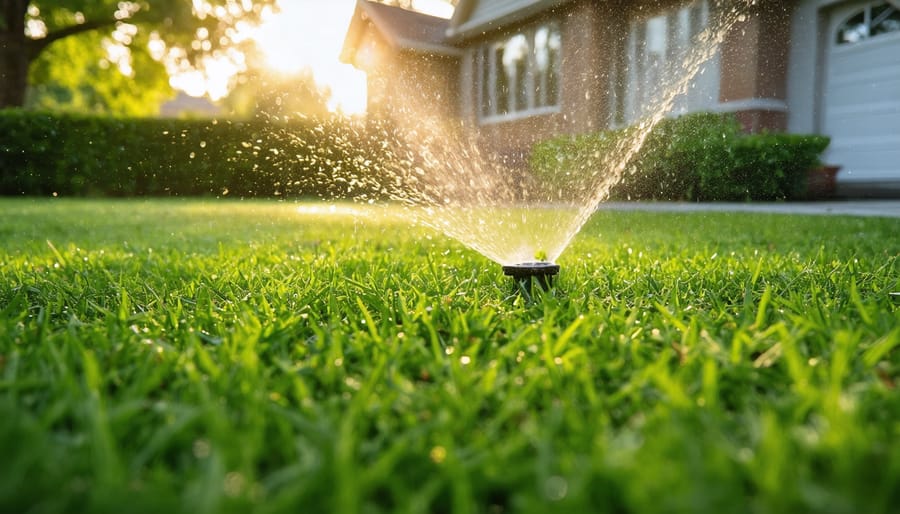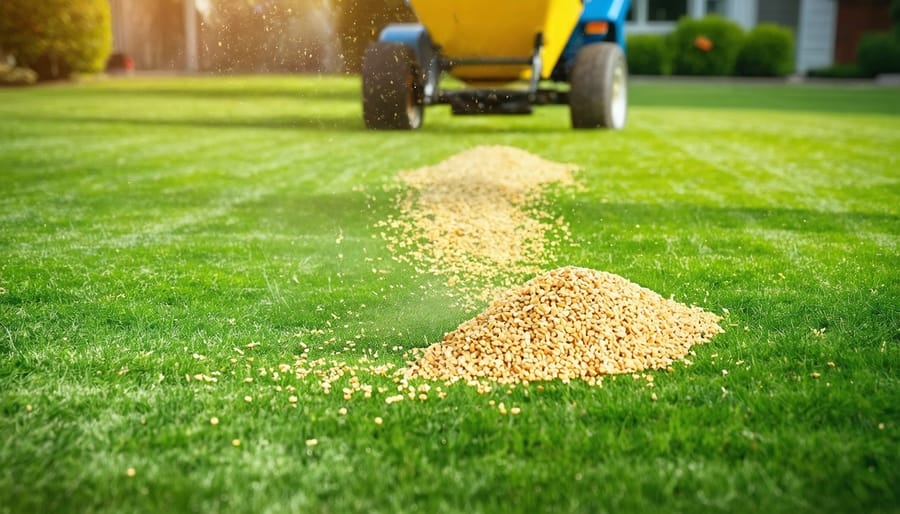Time your spring lawn fertilization perfectly by waiting until soil temperatures consistently reach 55°F (13°C) – typically when grass starts actively growing and lilacs begin to bloom. Test soil moisture by walking on the lawn; if footprints quickly disappear, conditions are ideal for fertilization. Apply a balanced, slow-release nitrogen fertilizer (like a 20-5-10 blend) only after the first two spring mowings to ensure your grass has emerged from winter dormancy and is ready to efficiently utilize nutrients. This strategic timing and proper fertilizer selection creates the foundation for a lawn thriving throughout summer while preventing nutrient runoff and environmental damage. Measure your lawn’s square footage accurately and calibrate your spreader to avoid over-fertilization, which can lead to rapid, weak growth and increased disease susceptibility.
Signs Your Lawn is Ready for Spring Fertilizer
Soil Temperature Guidelines
Soil temperature is a crucial indicator for determining the perfect time to fertilize your spring lawn. The ideal soil temperature range for applying fertilizer is between 55°F and 65°F (13-18°C), as this is when grass roots become active and can effectively utilize the nutrients.
To measure soil temperature accurately, use a soil thermometer inserted about 2-3 inches into the ground. Take readings at the same depth in several locations across your lawn, preferably in the morning, to get an accurate average. For best results, check the temperature for three consecutive days – if it consistently stays above 55°F, you’re in the sweet spot for fertilizing.
Don’t have a soil thermometer? Here’s a handy tip: when soil temperatures reach this range, you’ll typically notice lilacs beginning to bud and forsythia starting to bloom. These natural indicators can serve as reliable guides for timing your fertilizer application.
Remember that soil warms up more slowly than air temperature, so don’t rely on weather forecasts alone. Taking the time to ensure proper soil temperature will maximize the effectiveness of your fertilizer and promote healthy grass growth.

Visual Growth Indicators
Before reaching for that fertilizer, look for clear signs that your lawn is ready for its spring feeding. The most reliable visual indicator is consistent grass growth across your lawn. When you notice your grass reaching a height that requires regular mowing, typically 2-3 inches, this signals active growth and nutrient uptake capability.
Watch for the color of your lawn as well. A healthy spring lawn should display a natural green hue. If you spot patches turning pale green or yellowish, your grass might be signaling its readiness for nutrients. However, don’t confuse winter dormancy recovery with nutrient deficiency – wait until you see actual new growth.
Pay attention to soil temperature by observing other plants in your yard. When you notice weeds starting to emerge and early spring flowers blooming, it’s usually a good indication that soil temperatures have warmed enough for grass roots to actively absorb nutrients.
Another reliable sign is root development. Gently pull up a small tuft of grass – if you see white, healthy roots actively growing, your lawn is ready for fertilization. Remember, these visual cues work together with seasonal timing to help you make the best decision for your lawn’s health.
Optimal Spring Fertilization Windows

Early Spring (March-April)
Early spring presents the perfect opportunity to give your lawn that much-needed nutritional boost after the dormant winter months. As temperatures consistently reach above 55°F (13°C) and grass begins showing signs of active growth, usually in March or April depending on your region, it’s time to apply your first round of fertilizer.
This timing is crucial because your lawn is actively developing its root system during this period. The soil has typically thawed enough to allow nutrient absorption, while the moderate temperatures create ideal conditions for grass to efficiently utilize the fertilizer. By feeding your lawn early, you’re supporting robust root development that will help your grass withstand summer stress later in the season.
For best results, wait until you’ve mowed your lawn at least once in the spring. This indicates that your grass has emerged from dormancy and is actively growing. Look for other natural indicators too – if you notice spring bulbs blooming or tree buds swelling, these are good signs that the soil temperature is right for fertilization.
Remember to check your soil’s moisture level before applying fertilizer. The ground should be moist but not waterlogged. Early morning application is ideal, as it gives the fertilizer time to absorb before evening dew sets in. This timing also helps prevent nutrient runoff and promotes more efficient uptake by your lawn.
Late Spring (May-June)
Late spring is a crucial time for lawn fertilization, as your grass is now fully awake and actively growing. The period between mid-May and early June offers ideal conditions for feeding your lawn, setting it up for success as you transition into summer lawn maintenance.
During this time, soil temperatures consistently remain above 65°F (18°C), which means grass roots are actively absorbing nutrients. Your lawn has likely used up much of the nutrients from any early spring application, making this the perfect time for a second feeding. This late spring application helps strengthen your grass before the stress of summer heat arrives.
For best results, time your fertilization just before a light rain or water the lawn immediately after application. This helps the nutrients penetrate the soil effectively while preventing fertilizer burn. Choose a balanced fertilizer with a higher nitrogen content (look for numbers like 20-5-10) to promote strong leaf growth and deep green color.
Remember to mow your lawn at least once before fertilizing, and ensure the grass is dry when you apply. If you’ve overseeded in early spring, wait until you’ve mowed the new grass at least three times before applying fertilizer. This timing ensures young grass has established strong enough roots to handle the nutrients without burning.
This late spring feeding is particularly important if you want a lawn that stays resilient through the hot summer months ahead.
Choosing the Right Fertilizer Type
Selecting the right fertilizer for your spring lawn care routine is crucial for achieving optimal results. The key is to choose a product that matches both your grass type and the specific needs of your lawn during the spring growing season.
For spring applications, look for fertilizers with a balanced NPK ratio (such as 20-5-10 or 24-4-8), where the first number (nitrogen) is highest. Nitrogen promotes the lush, green growth that lawns need coming out of winter dormancy. However, don’t go overboard with high-nitrogen fertilizers, as this can lead to excessive growth that weakens your grass over time.
Cool-season grasses like Kentucky bluegrass and fescue benefit from slow-release fertilizers that provide steady nutrition throughout the spring. These typically contain both quick-release and controlled-release nitrogen sources, giving your lawn an immediate boost while ensuring sustained feeding.
For warm-season grasses such as Bermuda or Zoysia, wait until they show clear signs of emerging from dormancy before applying fertilizer. These grasses typically need slightly higher nitrogen levels to support their aggressive growth pattern during warm weather.
Consider using organic fertilizers, which offer several advantages for spring applications. They release nutrients gradually, promote beneficial soil microorganisms, and are less likely to burn your lawn. While organic options might work more slowly than synthetic fertilizers, they contribute to long-term soil health and sustainable lawn care practices.
Don’t forget to read the label carefully for application rates. A good rule of thumb is to apply no more than 1 pound of nitrogen per 1,000 square feet in a single application. Many modern fertilizers come with clear measuring guidelines and spreader settings to help you apply the right amount.
If you’re unsure about your lawn’s specific needs, consider getting a soil test done. This will help you choose a fertilizer with the right nutrient balance for your particular situation and avoid wasting money on unnecessary supplements.

Environmental Considerations
When fertilizing your lawn in spring, weather conditions play a crucial role in both timing and effectiveness. Ideally, you’ll want to apply fertilizer when temperatures consistently stay between 55-65°F (13-18°C), and soil has warmed up sufficiently. This usually coincides with the time when grass begins actively growing.
Rainfall patterns are particularly important to consider. While you want some moisture in the soil, avoid fertilizing right before heavy rain is forecast, as this can lead to runoff and waste. The nutrients might wash away before your lawn can absorb them, potentially contaminating local waterways. Instead, aim for a day when light rain is expected or when you can implement water-efficient lawn care practices to help the fertilizer penetrate the soil.
Environmental impact should be a top priority in your fertilization strategy. Over-fertilizing not only wastes money but can harm beneficial soil microorganisms and contribute to water pollution. Consider using slow-release organic fertilizers, which are gentler on the environment and provide sustained nutrition to your lawn.
Pay attention to your local ecosystem as well. If you live near water bodies, maintain a buffer zone where you either avoid fertilizing or use minimal amounts. This helps protect aquatic life and water quality. Additionally, check your local regulations regarding fertilizer use, as some areas have specific restrictions during spring months to protect water resources.
Remember that a healthy lawn naturally requires less fertilizer, so focus on building good soil health through proper mowing, appropriate watering, and natural amendments like compost.
Common Spring Fertilization Mistakes
Even well-intentioned gardeners can make crucial mistakes when fertilizing their lawns in spring. One of the most common errors is fertilizing too early, before the grass has fully awakened from winter dormancy. This premature feeding can stimulate leaf growth at the expense of root development, leaving your lawn vulnerable to disease and unable to prevent heat stress later in the season.
Another frequent mistake is applying too much fertilizer in a rush to green up the lawn. This “more is better” approach can lead to nutrient burn, destroying grass blades and potentially contaminating local waterways through runoff. Instead, always follow package instructions and consider using a slow-release formula.
Timing fertilization just before heavy rain is also problematic. While it’s true that lawns need water to help absorb nutrients, heavy rainfall can wash away expensive fertilizer before it has a chance to benefit your grass. Aim to apply fertilizer when light rain is forecast or when you can water it in yourself with controlled irrigation.
Lastly, using the wrong type of fertilizer for your specific grass type and soil conditions can waste both time and money. Before applying any fertilizer, conduct a soil test to understand what nutrients your lawn actually needs. This targeted approach is not only more effective but also more environmentally responsible.
Successful spring lawn fertilization comes down to timing, preparation, and proper technique. Remember that the best time to fertilize your lawn is typically when soil temperatures consistently reach 55°F (13°C), usually a few weeks after your grass begins actively growing. By waiting for these optimal conditions, you’ll ensure your lawn makes the most of the nutrients you provide.
Keep in mind the key factors we’ve discussed: soil testing, grass type, and local climate patterns. These elements will help you make informed decisions about both timing and fertilizer selection. For the best results, aim to fertilize when your grass is dry but the soil is moist, and always follow package instructions for application rates.
Remember to prioritize environmental responsibility by avoiding over-fertilization and choosing slow-release products when possible. A well-planned spring fertilization schedule not only promotes a healthy, vibrant lawn but also supports sustainable gardening practices. With these guidelines in mind, you’re well-equipped to give your lawn the strong start it needs for a successful growing season.




